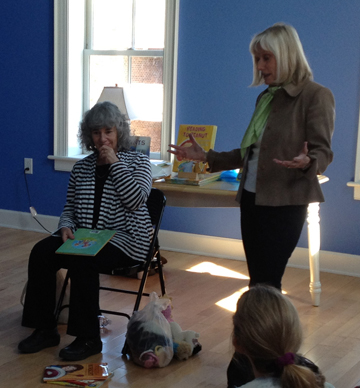Every week, a member of the New England Independent Booksellers Association board has written the membership with a Question of the Week. This past week, board president Annie Philbrick wondered: With the impending loss of Google eBooks in January 2013, the ABA is looking into all options for the sale of eBooks in indies. If the ABA were to partner with a company that would allow independent bookstores to sell an eReader device and eBooks, would you sell this device in your store? Or would you just sell the eBooks on your website? Or neither?
This is a very good question. Made more complicated because, while I’m an ABA member store, I have my website through someone else, so gains made for IndieCommerce websites might not apply to me.
We have been selling eBooks for months now and sold very few. We have sold some, but is it enough to spend dues money pursuing? Or, has the eBook ship essentially missed the indies in any substantive way? I hear more and more customers talking about their Kindles, iPads and eReaders, but are these customers just too conditioned to download their content from websites that do it better than I do? Should I stick what I do best, which is sell books, with pages, covers, and that delicious book smell, or do indies go head to head and bring their own eReader to the market?
I just don’t know.
As much as I hate to say it, I do think we’re a little late to the ball. To bring a new kind of eReader to the market that’s indie specific, but would be competing with some very well done readers at affordable prices, seems untenable with the volume necessary to make it cost-efficient. I keep coming back to wondering why I can’t get eBooks directly from the publishers themselves. Maybe I missed the memo about it, but I have no idea why we can’t partner with publishers, Ingram, or Baker Taylor to fulfill our eBook needs. Even still, Amazon and iTunes just make it so easy, and that’s what’s been missing with indies and eBooks for the most part. If we do it, it’s got be done seemlessly and it’s got to be one or two steps of an easy, intuitive process.
I don’t know what the market will look like in six months or a year. I’d like to think that there will be enough people who refuse to read digitally that bookstores will be fine, but I could be guessing wrong.
So, I’m back to not knowing. Readers, how do you see the relationship with independent bookstores and eBooks? Any predictions for how the eBook/bookstore landscape might change in the next six months to a year?
When Little Ones Call
Josie Leavitt - April 27, 2012
The other day I was at work receiving an order when the phone rang. The phone rings all the time here, so that was hardly a surprise. The surprise was the little voice on the other end.
I answered the phone like I always do, “Flying Pig Bookstore.” I heard nothing but breathing. Something told me that this was not a dirty call, but rather someone small who wasn’t quite used to the phone. I said, “Hello. This is the Flying Pig Bookstore.” Then this little voice piped up and said, “Hello.” I asked if he needed anything and he said, “I’m just calling the Flying Pig.” I was puzzled why a small child, who couldn’t have been more than four, was calling the bookstore.
I asked if his mom was around. I heard bemused giggling as his mother came to the phone. She said this was her son’s first phone call. Somehow he figured out how to call us (I suspect from seeing the number on a tote bag at home) and just wanted to say hi to his favorite place. I was laughing and so touched by this little guy’s desire to call us. In the 16 years we’ve been in business I can safely say that a toddler has never purposely called us. How that little guy figured it out is wonderful.
So now for sure, when I hear heavy breathing on the line, I’ll just say, “Are you calling the bookstore again?”
A Costume Ball for Classic Books (A Lament)
Elizabeth Bluemle - April 26, 2012
Over the years, classic books — those (mostly) treasured tomes that have become part of the canon, taught in high schools and universities across the land — see their covers revamped every several years to become accessible to a new generation of readers. Or at least, that’s the hope.
Alert bookseller and periodic ShelfTalker guest blogger Kenny Brechner of DDG Booksellers in Farmington, Maine, has noticed that some of these covers are less successful than others in attracting their rightful readership, and he tells us why, most humorously.
Enjoy!
***********************
A Costume Ball for Classic Books
By Kenny Brechner, DDG Booksellers
 The idea of using specially designed cover art to cause teenagers to either buy classic books, actually read them when gifted, or approach homework relating to them with zeal, is not new. Nor can it be fairly said to have exclusively produced the advanced kind of failure which is the subject of this serious essay. There have been instances of success as seen at right. It is also true of course that there are young readers now, as there have always been, who enjoy reading great books from the past due to their innate disposition as readers. Nonetheless, there is a long standing tradition of cover art failure in marketing classics to young adults. This failure is identified by covers which have two particular qualities. First, the cover must truly appall, disorient, and imperil the sanity of any older reader who already loves the book provoking an immediate verbal exclamation of dismay. Second, it must only appeal to readers who will be certain to loathe the book itself and feel duped.
The idea of using specially designed cover art to cause teenagers to either buy classic books, actually read them when gifted, or approach homework relating to them with zeal, is not new. Nor can it be fairly said to have exclusively produced the advanced kind of failure which is the subject of this serious essay. There have been instances of success as seen at right. It is also true of course that there are young readers now, as there have always been, who enjoy reading great books from the past due to their innate disposition as readers. Nonetheless, there is a long standing tradition of cover art failure in marketing classics to young adults. This failure is identified by covers which have two particular qualities. First, the cover must truly appall, disorient, and imperil the sanity of any older reader who already loves the book provoking an immediate verbal exclamation of dismay. Second, it must only appeal to readers who will be certain to loathe the book itself and feel duped.
 A classic example can be seen to the right in this cover to the 1991 Bantam edition of The Worm Ouroboros. The Worm is one of my favorite books and I can tell you with honest conviction that it fulfills the first of our criteria admirably. Even at this respectable distance of years the pain is still fresh. The perverse genius of the design is that the cover makes it appear that the book contains fantasy pap circa 1986-91: one reasonably expects a weak Tolkien rip off with magical beasts, quests, some sword fighting and some hot damsels. No literary minded person would get within reading distance of it. Secondly, anyone to whom the cover appealed would be quickly and totally disappointed to find a highly literary fantasy with Saga roots and archaic English arrayed upon the pages. The cover is a perfect failure, it repels its true audience, and attracts only people who will find it unpalatable.
A classic example can be seen to the right in this cover to the 1991 Bantam edition of The Worm Ouroboros. The Worm is one of my favorite books and I can tell you with honest conviction that it fulfills the first of our criteria admirably. Even at this respectable distance of years the pain is still fresh. The perverse genius of the design is that the cover makes it appear that the book contains fantasy pap circa 1986-91: one reasonably expects a weak Tolkien rip off with magical beasts, quests, some sword fighting and some hot damsels. No literary minded person would get within reading distance of it. Secondly, anyone to whom the cover appealed would be quickly and totally disappointed to find a highly literary fantasy with Saga roots and archaic English arrayed upon the pages. The cover is a perfect failure, it repels its true audience, and attracts only people who will find it unpalatable.
Creating classics for YA cover failure is not a static art however. It requires fresh ingenuity in order to continue to excite the respective vistas of horror and disappointment which are its trademark. The purpose of this essay is to remark upon the latest advancements, propose some fresh techniques, and solicit your involvement in this ongoing struggle to convince average teen readers that publishers, educators, and booksellers are devious, clueless, and not to be trusted. An easy path to failure would be to choose a classic which few teenagers would actually enjoy reading under any circumstances, such as Pamela or Moll Flanders. We are interested in the sterner challenge of protecting classics from being read by teenagers who would actually like them. Let us look then at three examples of modern, innovative, state of the art failure provided below with commentary. These examples will be followed by our own attempt at a substantive contribution to this important effort.

This is a bold design which succeeds admirably at failing in both categories. Its ability to horrify Wuthering Heights fans proved to be very pronounced in our test group. One tester, after her eyes lit on the cover, literally shrieked in pain saying. “Are you telling me this is real? This isn’t even period. Didn’t someone tell them that it wasn’t a regency romance? Why is this happening? AAAH I can’t look at it anymore.” Others noted that Catherine’s dress would have been quite something to try and walk along the wild moors in. Another tester remarked that “Heathcliff looks more like the quiet guy who sits behind you in chem class, the one your parents wish you would date instead of that long-haired ne’er-do-well you’ve taken up with.” In short, the cover’s ability to completely misrepresent the characters it portrays caused universal feelings of revulsion in our test group. Mission accomplished vis-à-vis appalling familiar readers. In terms of the second element—alluring only new readers who will then dislike the book—Wuthering Heights has a strong appeal to young readers and there is thus an almost unavoidable amount of inadvertent success which is sure to occur with any version. Nonetheless, the vapidly romantic nature of the cover does strongly insure that those teenagers who are too shallow to enjoy Wuthering Heights will be the likeliest ones to open the book.


Now I know what you’re thinking. “These are strong designs, and easy for you to criticize. Can you do better? Do you have anything to offer?” Our design team, fully alive to the need to contribute rather than simply react, undertook these following two examples at capturing a bold new direction.


Let us suspend disbelief and consider things differently. What if horrifying familiar readers and pushing away all but the wrong prospective readers isn’t our goal? In his essay, How to Fail in Literature, Andrew Lang observed that “If anyone has kindly attended to this discourse, without desiring to be a failure, he has only to turn the advice outside in.” Good advice, but I think it is simpler than that. Suppose that there was one prerequisite for a professional producing the cover of a classic book, that the producer must have read and have loved the book. That would cure all. Real romance is not hard to seek in Wuthering Heights. There is no more romantic scene in all of literature that that in which Heathcliff declares, “Kiss me again; and don’t let me see your eyes! I forgive what you have done to me. I love my murderer – but yours! How can I?” All that’s wanted is a loving hand to capture it.
And so now we turn to you: can you top the covers here, for better or for worse? Send them here! Any thoughts on this weighty matter, set them down below.
It’s Fun Being Fancy
Josie Leavitt - April 25, 2012
Yesterday, we hosted Jane O’Connor, author of the stunningly popular Fancy Nancy series. We rented our local Town Hall to contain the more than 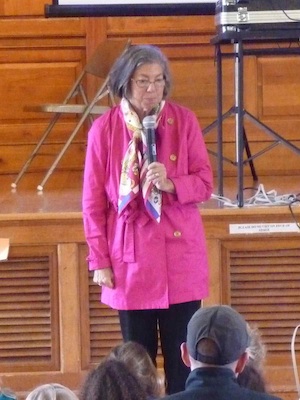 200 fans, who
200 fans, who 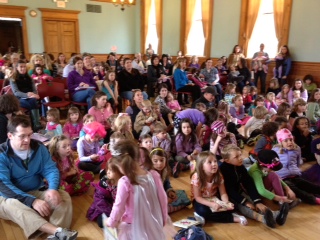 ranged in age from four months to ten years. What united this mostly female crowd was a deep abiding love of all things fancy.
ranged in age from four months to ten years. What united this mostly female crowd was a deep abiding love of all things fancy.
We had all the books, four tables worth, and the crowd was very happy to buy the new book, Nancy Clancy: Super Sleuth, the first in her new chapter book series. People were buying stacks of yummy books, almost all festooned with glitter.
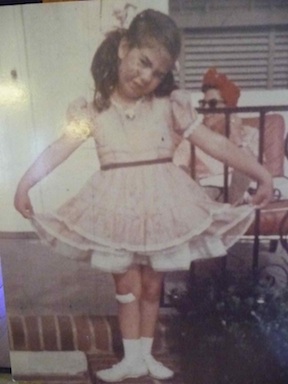 fancy since she was a little girl, and she had a photo to prove it.
fancy since she was a little girl, and she had a photo to prove it.The kids jus
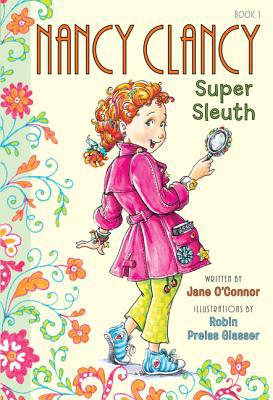 t had so much fun. Some were dressed up with fancy clothes, one young girl had on a wig! Jane’s presentation began with a question: did the crowd know what accessories were? Little hands flew up, eager to answer. One young girl asked,” Are leg warmers accessories?” Jane goodnaturedly said yes.
t had so much fun. Some were dressed up with fancy clothes, one young girl had on a wig! Jane’s presentation began with a question: did the crowd know what accessories were? Little hands flew up, eager to answer. One young girl asked,” Are leg warmers accessories?” Jane goodnaturedly said yes.Jane then had a really fun Power Point presentation about the new book that featured the fancy words detectives use. It was awfully cute watching tiny kids say things like culprit, motive, and suspect. The last activity involved bananas. I’ll admit, I was skeptical. But it all became clear once the six young people who were chosen earlier by Jane (a brilliant idea that avoided total chaos by asking for volunteers) learned that the best way to work on their posture is by balancing a banana on their heads.
This event was a lot of fun. It’s not every day I can rock out in a tiara at work.
A Visit with Jason Chin
Josie Leavitt - April 23, 2012
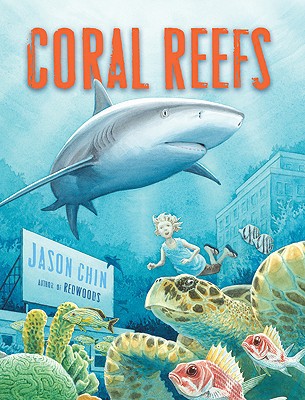
This past Saturday, we hosted illustrator Jason Chin for a very entertaining visit. Jason’s books, Coral Reefs and Redwoods, are great books about imagination and they teach about ecology and nature in a very accessible way. The kids all seemed to know his books. In fact I must say that this was the first time, ever, we were in peril of running out of books before the event. Thankfully, Jason had books with him, so everyone got the books they needed.
I love it when ill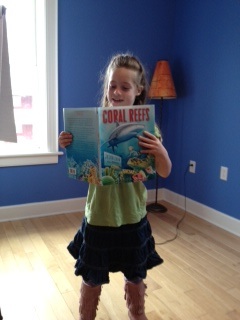 ustrators draw during events. Jason had a very clever way to get the kids involved with his drawing. It started with him writing: When I read the book it took me to blank. Then we picked a place. The kids agreed on Africa. Then Jason explained that he needed someone to be the “I”. A very bright young girl volunteered to be the model. Elizabeth Motch was her name and she was great at holding still while lookin
ustrators draw during events. Jason had a very clever way to get the kids involved with his drawing. It started with him writing: When I read the book it took me to blank. Then we picked a place. The kids agreed on Africa. Then Jason explained that he needed someone to be the “I”. A very bright young girl volunteered to be the model. Elizabeth Motch was her name and she was great at holding still while lookin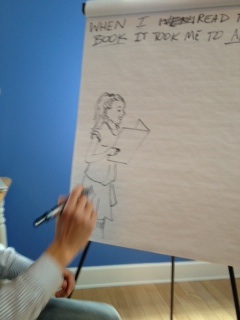 g surprised and nervous. Jason’s rendition of this girl was great.
g surprised and nervous. Jason’s rendition of this girl was great.
Now, the fun really began. All the kids shouted out different kinds of animals and 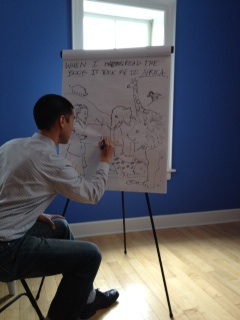 Jason drew them accurately (I was sort of amazed how quickly he could that without needing some sort of reference) and we had fun watching him figure out where they should all go. It was amazing to watch him just focus for a moment and then take less than a minute to draw each animal.
Jason drew them accurately (I was sort of amazed how quickly he could that without needing some sort of reference) and we had fun watching him figure out where they should all go. It was amazing to watch him just focus for a moment and then take less than a minute to draw each animal.
Jason’s process for his books fascinate me. He does thumbnail sketches for all the possible pages of the book to get a feel for how the book might flow. Jason, like many illustrators who are now writing their books as well, said he struggles a little bit with the words, although I find that his text and art work beautifully together.
Luckily for us, Jason lives down the road, so I can get signed stock (there were no copies of Coral Reefs left for the store) back on Tuesday. One of the cutest moments of the event was when Jason’s toddler son, Liam, wondered up when Jason was drawing and just checked out the drawing, nodded and went back to his mom. It was almost as if he was making sure his dad’s work passed muster. And it did.
Souped-Up Story Hour
Elizabeth Bluemle - April 19, 2012
At a staff meeting early this year, we were brainstorming event ideas. One of our staff members, Juanita (aka JP), suggested enhancing our weekly Wednesday morning story hours with one special visit from a Vermont picture book author or illustrator each month. What a simple, brilliant suggestion! Usually, picture book events take place on Saturday mornings, and while that is a wonderful time to have them, taking advantage of our built-in story hour crowd also makes so much sense, I can’t believe we didn’t think of it earlier. Go, JP!
Our first Souped-Up Story Hour, back in February, featured Liza Woodruff (illustrator of Kim Norman’s Ten on the Sled and Todd Tarpley’s How About a Kiss for Me?, among others). Josie blogged about her visit here in a post on local partnerships.
In March, we hosted Amy Huntington, illustrator of Katie Clark’s Grandma Drove the Garbage Truck and Grandma Drove the Snowplow (Grandma Drove the Lobster Boat comes out in June), and several other fun books. (Sadly, we couldn’t blog about that event because I was out of town and Josie was handling some bookstore crisis downstairs, but everyone raved about it!)
April’s special guest was Leda Schubert, a quadruple threat of a children’s book author with her background as a former school teacher, librarian, school library consultant for the Vermont Department of Education for 17 years, and current role as Vermont College of Fine Arts faculty member in the MFA program in Writing for Children and Young Adults. Whew!
I met Leda years ago on Vermont’s Dorothy Canfield Fisher Award committee for children’s literature. She was a permanent founding member, and I served on the committee for six years. I was bowled over by Leda’s knowledge about books, deep and wonderful sense of humor, passion for accuracy and citation in nonfiction for children, and abiding love of dogs. Leda was also responsible for letting me know about the Vermont College program, which changed my writing life forever. We were in the same class together as students back in the day.
So you can imagine that it’s always a treat for me to see Leda, and a special joy to hear her read her books to children. Because of her vast experience with kids and books, she has an unerring sense of what they will enjoy in a story, and how to talk to a room full of bright, funny preschoolers.
It’s been a wonderful series so far. May’s Souped-Up Story Hour Guest is Tracey Campbell Pearson, and you’ll be hearing about her visit in a future blog post!
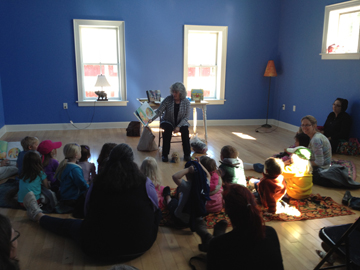
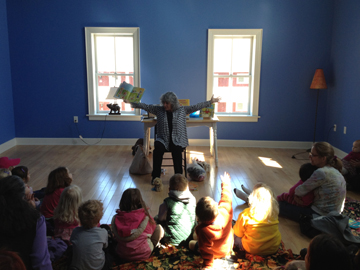
Fifty Shades of Red
Josie Leavitt - April 18, 2012
I spent much of yesterday laughing. I was laughing with the women who slunk in looking for the second and third books in the Fifty Shades of Grey series. The women were all well above 18 and all, save one, were married and most had children. That these books have so captivated yet simultaneously embarrassed women is hilarious to me and them.
There were two kinds of shoppers yesterday. The bold ones who proudly strode up to the counter eagerly eying the books and thumbing through them while being rung up. The sheepish ones practically pointed mutely while turning crimson and dashing out of the store. Most calls about the books were made from garbled cell phones and went like this: “Do you have them?”
I felt a little bit like a drug dealer with fresh product. It’s nice to be popular, but I wish there was less slouching about the books. There’s nothing wrong with reading erotica. No one here cares what people read. Honestly, I’m mostly thrilled that women are so energized by these books. We’ve certainly had extremely lively conversations in the last few weeks, and that has been delightful.
I do have to share one classic story about these books. After school yesterday, a first grade teacher at the local school came in already blushing. She saw the books on the front counter and as she picked up and slid her two books toward me she muttered, “I know it’s gross, but I just have to find out what happens.” She was blushing so hard, I swear I could feel the heat coming off her face. She had hoped to dash in and dash out. Sadly for her, one of her students came in with his father. She saw him and at first actually tried to hide, but she realized she was caught, and fumbled to get the books tucked in her jacket before William saw them.
I tried not to laugh, but it had been a long day of red-faced grown women and I found the whole thing endlessly entertaining.
Bailing on Special Orders
Josie Leavitt - April 16, 2012
Admittedly, this issue frustrates me. When people order a book that we specially order for them that they never pick up, or worse, to suggest it’s somehow my fault that they had to get the book somewhere else, it’s disheartening.
Let me explain our very straightforward process. A customer calls or comes in to ask for a book. If we don’t have the book, we’ll always order it for folks. We don’t ask for pre-payment because we don’t want to hold on to the customer’s money in case there’s a problem getting the book. We trust that the customer will get the book from us. When the book comes in, we call them and let them know the book is here for them. We do not put the book on the hold shelf until we’ve left a message. We date the form that wraps the book so we know when we’ve contacted the customer. Periodically, we purge our special order shelves, but first we call everyone who has had a book on the shelf for more than a month, or more likely, three. This usually results in people apologizing about forgetting and then coming in to buy the book. Every once in a while these calls result in sheepish customer calls to the store about how they already got the book somewhere else.
One woman called last week in response to one our reminder calls and said, “My husband just now told me you called two weeks ago. But since I hadn’t heard from you, I went ahead and downloaded it from Amazon.” Ouch. So, now I’ve lost a sale because a husband can’t take and deliver a message. I could do without the accusatory tone. If someone is eager for a book, they can always call and we can track the order and find out where it is and when it will be in the store. After 16 years of not taking money for special orders, I am considering taking money for them because I tire of being stuck with more stock than I need.
But before I take this step, I’m curious how folks feel about this. Do you think it’s okay to ask for pre-payment? How do you feel when you’re asked to pay for your special order in advance? And booksellers: how does your store handle special order payment?
Choosing Little League Over a Bookstore Appearance?
Josie Leavitt - April 13, 2012
We have been planning a poetry event since February with two formerly local poets. Many emails were exchanged to find a date that worked with both writers because of the travel involved. Finally, a date was found that worked with everyone, a Saturday night, which is not our preferred event night because so many other things compete with it, but it was the only night one of the poets could do. I was relieved as now I could start promoting the event.
Promoting an event is a two-month process for us. First, the event goes on our website. Then we send calendar listings to the local papers. After that we write press releases and send them to all the media outlets in the area. Elizabeth then makes a flyer for the event. Lately, she’s been doing handbills that folks can take away with them. These are much more cost-effective than a single-page color sheet. After this, Elizabeth will add the event as a teaser in the prior month’s email event blast.
Then six weeks before the event, we’ll place our book order. In this case we took advantage of a backlist special and perhaps ordered a few too many books. But we were excited about the event and wanted to have all the author’s books to create a very full in-store display. This particular event is set for the end of the month.
Luckily for us this particular event featured two poets. I just got an email from the poet whose schedule we accommodated that he can’t come to the event because it’s the same day as his son’s first Little League game. While I applaud this man’s parenting involvement, I can’t help being really irritated. Now, all of his books have to be returned, at my expense, because of a seven-year’s old baseball game. (The author doesn’t live locally, so I can’t even get stock signed.) Surely, there will be an infinite number of ball games in this child’s life, so why this one can’t be missed for the sake of being a professional is a little lost on me. I would think setting a good example of honoring commitments would be an important lesson for the child to learn. Perhaps he should have thought that there would be a strong possibility of a ball game on a Saturday in April and planned a little better.
So, I find myself in the unique position of having lost money on an event before it’s begun. I think it’s safe to say that our store event meant little to this man or he wouldn’t have cancelled so blithely, two weeks before the event.
It’s times like this that I remind myself, it’s just books. I’m not a heart surgeon, no one’s life is in peril, but wow, it is galling to be treated with such little regard.
Epilogue: I have to add this because it was heartening. After his cancellation email, the author sent a second email, volunteering to pay our freight costs back to the publisher. Of course, we will not actually ask him to cover that, but his offer meant a lot. His reason for going to the game is, of course, valid and good. Not only is he being a great dad, his son is a great kid. So, while it was a frustrating turn of events and I wish we’d had more notice, I now feel a little sheepish for my tone. (The lesson I’ve learned from this is to wait a few hours between the inciting event and writing the post.)
If You Could Say ONE Thing to That Aspiring Picture-Book Writer…
Elizabeth Bluemle - April 12, 2012
Next week, I’ll be teaching the first of a three-part picture-book workshop, hoping to share with fellow writers some of what I’ve learned about craft and the magic of reaching kids through a form that offers so much freedom in such a focused space. Josie’s blog post yesterday interested me; learning that 66% of last year’s top-selling backlist children’s books were picture books (!) was both gratifying and eye-opening. Many of those bestselling titles are from decades ago — popular favorites whose sales are fueled in part by nostalgia and cultural familiarity, but in larger part by their enduring quality.
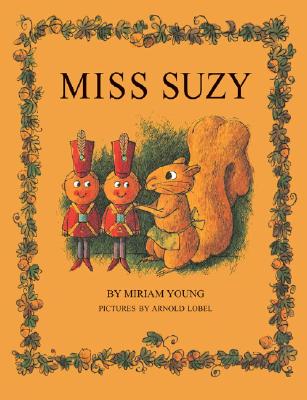 So what makes a picture book endure? What makes it speak to children across generations? Why is Miriam Young and Arnold Lobel’s Miss Suzy (not on that bestseller list, but similarly beloved) still the kind of book families go crazy over, almost 50 years later?
So what makes a picture book endure? What makes it speak to children across generations? Why is Miriam Young and Arnold Lobel’s Miss Suzy (not on that bestseller list, but similarly beloved) still the kind of book families go crazy over, almost 50 years later?
Here’s my tip (actually, it’s FIVE): I would say it has something to do with qualities that Jerry Griswold identified as recurring themes in classic children’s literature. In Feeling Like a Kid: Childhood and Children’s Literature (Johns Hopkins University), Griswold finds that “five themes recur in classic and popular works of children’s literature,” and they are snugness, scariness, smallness, lightness, and aliveness. Yes! Brilliant. He discovers these themes in novels as well as in picture books, of course. Don’t you love this observation and now feel compelled to assess your favorite books (and perhaps your own work) with an eye to those five qualities? Thank you, Professor Griswold. (The book title links to Indiebound, for anyone who would like to track down a copy of the book for his or her own library.)
So that’s one of the tidbits I’ll be sharing next week with my workshop participants. I’ll also be sharing examples of enduring picture books, both classic and contemporary, including many from the Bank Street College of Education’s Children’s Book Committee’s wonderful new roundup of Best Children’s Books of the Year, 2012.
It occurred to me that you editors and publishers out there (and you picture book master authors, as well) might have some tidbits of your own that you wish you could share with the writers, filled with hope and dreams and flashes of greatness and the typical authorial stumblings we all make, who send you their picture book manuscripts.
If you could say one helpful thing to these writers, what might it be? I will happily share your thoughts (attributed or anonymous, as you prefer) with the hope of bringing both inspiration and practical magery to the workshop.

